Guy Amir
Hard to Explain: On the Computational Hardness of In-Distribution Model Interpretation
Aug 07, 2024Abstract:The ability to interpret Machine Learning (ML) models is becoming increasingly essential. However, despite significant progress in the field, there remains a lack of rigorous characterization regarding the innate interpretability of different models. In an attempt to bridge this gap, recent work has demonstrated that it is possible to formally assess interpretability by studying the computational complexity of explaining the decisions of various models. In this setting, if explanations for a particular model can be obtained efficiently, the model is considered interpretable (since it can be explained ``easily''). However, if generating explanations over an ML model is computationally intractable, it is considered uninterpretable. Prior research identified two key factors that influence the complexity of interpreting an ML model: (i) the type of the model (e.g., neural networks, decision trees, etc.); and (ii) the form of explanation (e.g., contrastive explanations, Shapley values, etc.). In this work, we claim that a third, important factor must also be considered for this analysis -- the underlying distribution over which the explanation is obtained. Considering the underlying distribution is key in avoiding explanations that are socially misaligned, i.e., convey information that is biased and unhelpful to users. We demonstrate the significant influence of the underlying distribution on the resulting overall interpretation complexity, in two settings: (i) prediction models paired with an external out-of-distribution (OOD) detector; and (ii) prediction models designed to inherently generate socially aligned explanations. Our findings prove that the expressiveness of the distribution can significantly influence the overall complexity of interpretation, and identify essential prerequisites that a model must possess to generate socially aligned explanations.
Safe and Reliable Training of Learning-Based Aerospace Controllers
Jul 09, 2024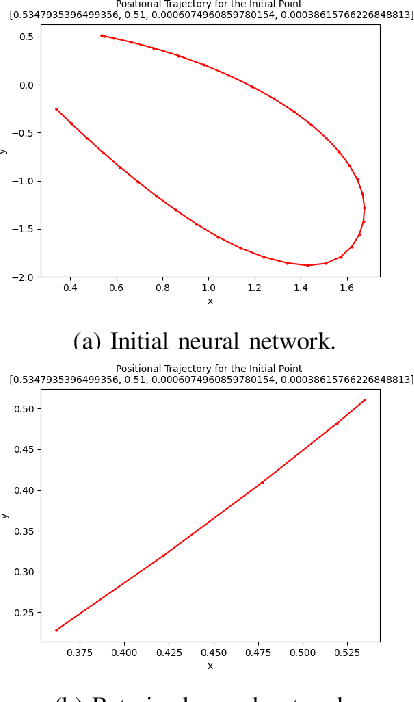


Abstract:In recent years, deep reinforcement learning (DRL) approaches have generated highly successful controllers for a myriad of complex domains. However, the opaque nature of these models limits their applicability in aerospace systems and safety-critical domains, in which a single mistake can have dire consequences. In this paper, we present novel advancements in both the training and verification of DRL controllers, which can help ensure their safe behavior. We showcase a design-for-verification approach utilizing k-induction and demonstrate its use in verifying liveness properties. In addition, we also give a brief overview of neural Lyapunov Barrier certificates and summarize their capabilities on a case study. Finally, we describe several other novel reachability-based approaches which, despite failing to provide guarantees of interest, could be effective for verification of other DRL systems, and could be of further interest to the community.
Verification-Guided Shielding for Deep Reinforcement Learning
Jun 10, 2024Abstract:In recent years, Deep Reinforcement Learning (DRL) has emerged as an effective approach to solving real-world tasks. However, despite their successes, DRL-based policies suffer from poor reliability, which limits their deployment in safety-critical domains. As a result, various methods have been put forth to address this issue by providing formal safety guarantees. Two main approaches include shielding and verification. While shielding ensures the safe behavior of the policy by employing an external online component (i.e., a ``shield'') that overruns potentially dangerous actions, this approach has a significant computational cost as the shield must be invoked at runtime to validate every decision. On the other hand, verification is an offline process that can identify policies that are unsafe, prior to their deployment, yet, without providing alternative actions when such a policy is deemed unsafe. In this work, we present verification-guided shielding -- a novel approach that bridges the DRL reliability gap by integrating these two methods. Our approach combines both formal and probabilistic verification tools to partition the input domain into safe and unsafe regions. In addition, we employ clustering and symbolic representation procedures that compress the unsafe regions into a compact representation. This, in turn, allows to temporarily activate the shield solely in (potentially) unsafe regions, in an efficient manner. Our novel approach allows to significantly reduce runtime overhead while still preserving formal safety guarantees. We extensively evaluate our approach on two benchmarks from the robotic navigation domain, as well as provide an in-depth analysis of its scalability and completeness.
Local vs. Global Interpretability: A Computational Complexity Perspective
Jun 07, 2024
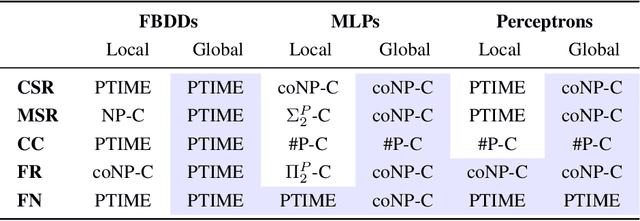
Abstract:The local and global interpretability of various ML models has been studied extensively in recent years. However, despite significant progress in the field, many known results remain informal or lack sufficient mathematical rigor. We propose a framework for bridging this gap, by using computational complexity theory to assess local and global perspectives of interpreting ML models. We begin by proposing proofs for two novel insights that are essential for our analysis: (1) a duality between local and global forms of explanations; and (2) the inherent uniqueness of certain global explanation forms. We then use these insights to evaluate the complexity of computing explanations, across three model types representing the extremes of the interpretability spectrum: (1) linear models; (2) decision trees; and (3) neural networks. Our findings offer insights into both the local and global interpretability of these models. For instance, under standard complexity assumptions such as P != NP, we prove that selecting global sufficient subsets in linear models is computationally harder than selecting local subsets. Interestingly, with neural networks and decision trees, the opposite is true: it is harder to carry out this task locally than globally. We believe that our findings demonstrate how examining explainability through a computational complexity lens can help us develop a more rigorous grasp of the inherent interpretability of ML models.
Shield Synthesis for LTL Modulo Theories
Jun 06, 2024Abstract:In recent years, Machine Learning (ML) models have achieved remarkable success in various domains. However, these models also tend to demonstrate unsafe behaviors, precluding their deployment in safety-critical systems. To cope with this issue, ample research focuses on developing methods that guarantee the safe behaviour of a given ML model. A prominent example is shielding which incorporates an external component (a "shield") that blocks unwanted behavior. Despite significant progress, shielding suffers from a main setback: it is currently geared towards properties encoded solely in propositional logics (e.g., LTL) and is unsuitable for richer logics. This, in turn, limits the widespread applicability of shielding in many real-world systems. In this work, we address this gap, and extend shielding to LTL modulo theories, by building upon recent advances in reactive synthesis modulo theories. This allowed us to develop a novel approach for generating shields conforming to complex safety specifications in these more expressive, logics. We evaluated our shields and demonstrate their ability to handle rich data with temporal dynamics. To the best of our knowledge, this is the first approach for synthesizing shields for such expressivity.
Verifying the Generalization of Deep Learning to Out-of-Distribution Domains
Jun 04, 2024



Abstract:Deep neural networks (DNNs) play a crucial role in the field of machine learning, demonstrating state-of-the-art performance across various application domains. However, despite their success, DNN-based models may occasionally exhibit challenges with generalization, i.e., may fail to handle inputs that were not encountered during training. This limitation is a significant challenge when it comes to deploying deep learning for safety-critical tasks, as well as in real-world settings characterized by substantial variability. We introduce a novel approach for harnessing DNN verification technology to identify DNN-driven decision rules that exhibit robust generalization to previously unencountered input domains. Our method assesses generalization within an input domain by measuring the level of agreement between independently trained deep neural networks for inputs in this domain. We also efficiently realize our approach by using off-the-shelf DNN verification engines, and extensively evaluate it on both supervised and unsupervised DNN benchmarks, including a deep reinforcement learning (DRL) system for Internet congestion control -- demonstrating the applicability of our approach for real-world settings. Moreover, our research introduces a fresh objective for formal verification, offering the prospect of mitigating the challenges linked to deploying DNN-driven systems in real-world scenarios.
Formally Verifying Deep Reinforcement Learning Controllers with Lyapunov Barrier Certificates
May 22, 2024Abstract:Deep reinforcement learning (DRL) is a powerful machine learning paradigm for generating agents that control autonomous systems. However, the "black box" nature of DRL agents limits their deployment in real-world safety-critical applications. A promising approach for providing strong guarantees on an agent's behavior is to use Neural Lyapunov Barrier (NLB) certificates, which are learned functions over the system whose properties indirectly imply that an agent behaves as desired. However, NLB-based certificates are typically difficult to learn and even more difficult to verify, especially for complex systems. In this work, we present a novel method for training and verifying NLB-based certificates for discrete-time systems. Specifically, we introduce a technique for certificate composition, which simplifies the verification of highly-complex systems by strategically designing a sequence of certificates. When jointly verified with neural network verification engines, these certificates provide a formal guarantee that a DRL agent both achieves its goals and avoids unsafe behavior. Furthermore, we introduce a technique for certificate filtering, which significantly simplifies the process of producing formally verified certificates. We demonstrate the merits of our approach with a case study on providing safety and liveness guarantees for a DRL-controlled spacecraft.
Analyzing Adversarial Inputs in Deep Reinforcement Learning
Feb 07, 2024Abstract:In recent years, Deep Reinforcement Learning (DRL) has become a popular paradigm in machine learning due to its successful applications to real-world and complex systems. However, even the state-of-the-art DRL models have been shown to suffer from reliability concerns -- for example, their susceptibility to adversarial inputs, i.e., small and abundant input perturbations that can fool the models into making unpredictable and potentially dangerous decisions. This drawback limits the deployment of DRL systems in safety-critical contexts, where even a small error cannot be tolerated. In this work, we present a comprehensive analysis of the characterization of adversarial inputs, through the lens of formal verification. Specifically, we introduce a novel metric, the Adversarial Rate, to classify models based on their susceptibility to such perturbations, and present a set of tools and algorithms for its computation. Our analysis empirically demonstrates how adversarial inputs can affect the safety of a given DRL system with respect to such perturbations. Moreover, we analyze the behavior of these configurations to suggest several useful practices and guidelines to help mitigate the vulnerability of trained DRL networks.
Marabou 2.0: A Versatile Formal Analyzer of Neural Networks
Jan 25, 2024
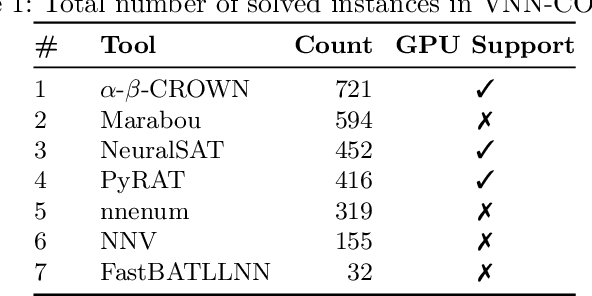

Abstract:This paper serves as a comprehensive system description of version 2.0 of the Marabou framework for formal analysis of neural networks. We discuss the tool's architectural design and highlight the major features and components introduced since its initial release.
Formally Explaining Neural Networks within Reactive Systems
Aug 06, 2023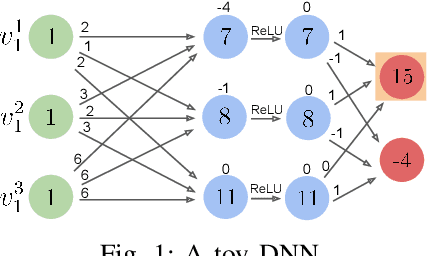
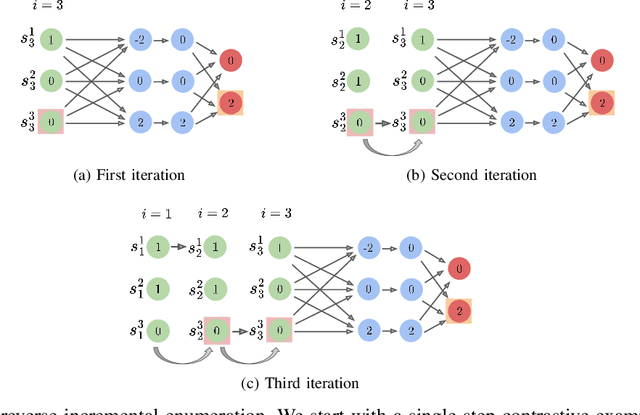
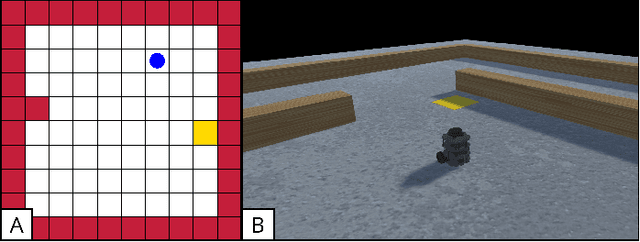
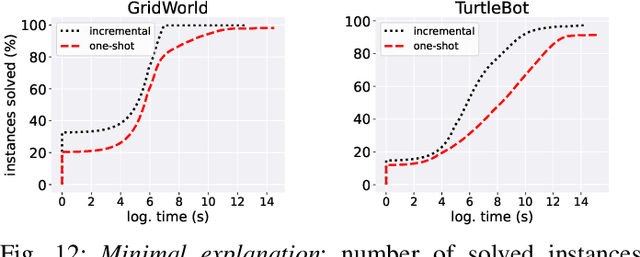
Abstract:Deep neural networks (DNNs) are increasingly being used as controllers in reactive systems. However, DNNs are highly opaque, which renders it difficult to explain and justify their actions. To mitigate this issue, there has been a surge of interest in explainable AI (XAI) techniques, capable of pinpointing the input features that caused the DNN to act as it did. Existing XAI techniques typically face two limitations: (i) they are heuristic, and do not provide formal guarantees that the explanations are correct; and (ii) they often apply to ``one-shot'' systems, where the DNN is invoked independently of past invocations, as opposed to reactive systems. Here, we begin bridging this gap, and propose a formal DNN-verification-based XAI technique for reasoning about multi-step, reactive systems. We suggest methods for efficiently calculating succinct explanations, by exploiting the system's transition constraints in order to curtail the search space explored by the underlying verifier. We evaluate our approach on two popular benchmarks from the domain of automated navigation; and observe that our methods allow the efficient computation of minimal and minimum explanations, significantly outperforming the state of the art. We also demonstrate that our methods produce formal explanations that are more reliable than competing, non-verification-based XAI techniques.
 Add to Chrome
Add to Chrome Add to Firefox
Add to Firefox Add to Edge
Add to Edge